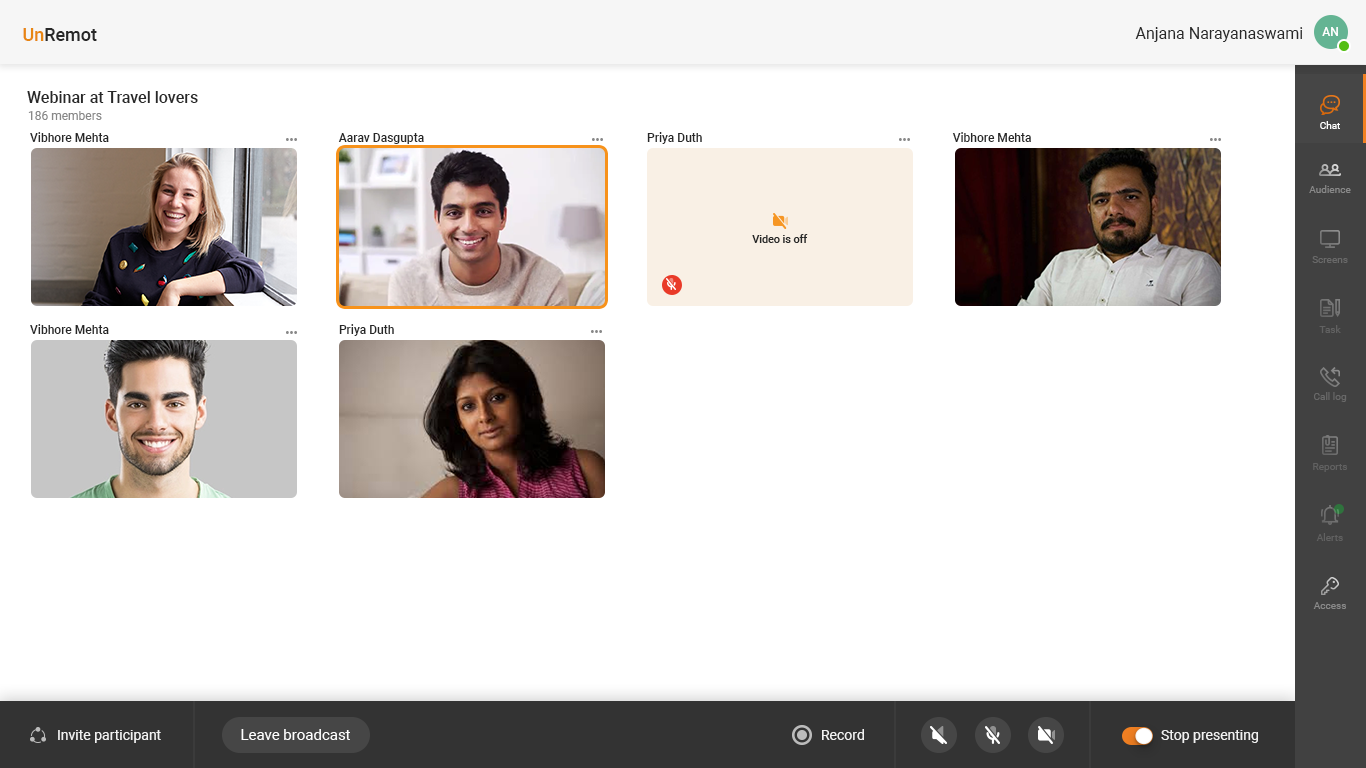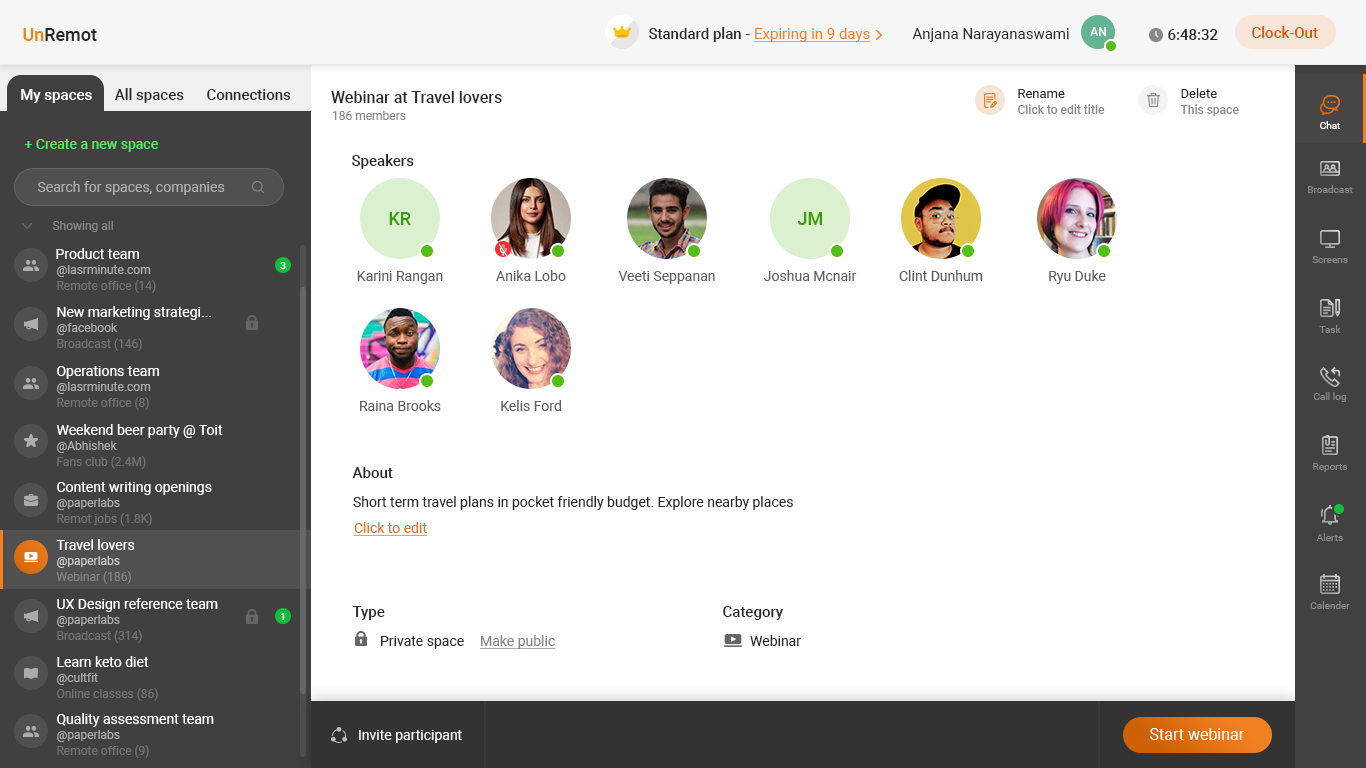The pandemic inflation has changed the world like none other. The influence is highly noticeable in employment were more on-site, on-premise work changed to a remote location, and work from home opportunities. Corporates are forced to adopt new methodologies to stay afloat in the business dynamics. What comes to rescue is remote training capabilities. Remote training is also prevalent in organizations having headquarters sparse in all the continents, growing branches everywhere throughout the world.
Did you know? According to Blueface predictions, remote working will be competing with office location by 2025. More than 50% of the people are opting to work full time remotely rather than to go on-premise work saving the time and cost thereby increasing productivity.
 Remote work policy | What it is & how you can create one easily!
Remote work policy | What it is & how you can create one easily!
What is Remote training/ virtual training terminology?
Remote training, also termed as virtual training, happens when the trainee and trainer are not present together but rather communicate via remote training software, connecting virtually. Data is commonly transmitted employing electronic mediums like email, conversation sheets, video gathering, audio calls with the goal that no physical nearness or proximity is required.
Remote training can happen simultaneously or non concurrently. Several companies spend a gigantic sum on employing qualified competitors, while some top organizations are expanding their financial plans to hone the ability of existing employees. Consistent training has its own set of advantages. This is a pivotal way to build a learned and talented workforce. Regular remote training is perceived as a business perk, particularly for progress within the organization verticals.
How to work from home successfully?
Fun Fact! Flexjob study suggested that 66% of the employees had their efficiency improved when not in an office, and 76% said there are fewer interruptions outside of workplaces.
What are some effective remote employee training strategies?
There is still confusion on how to train remote employees. Since there are no physical interactions among the peers or the trainer as such, there are certain effective remote employee training strategies that ensure smooth functioning of it. Here are a few ways how you can gain the maximum delivery of value via remote training:
1. Learning at one’s own sweet pace
- Self-paced training is always a better choice when it comes to learning fundamentals via Learning Management System
- No time bound restrictions and easy scheduling
- Learning Management System may constitute of training videos, resources like documents and presentations to aid in efficient learning
- Instructors giving hands-on live session can be quite helpful and general preferred mode of training
- A diversified weekly set curriculum where the learner gets to participate too at his own time
 Guide to conducting & attending Remote Interviews
Guide to conducting & attending Remote Interviews
2. Track the performance of the employee
- Gauge the team size to be trained and set a budget accordingly
- Find a cloud application which tracks the performance of the employees and get corresponding feedbacks too simultaneously
- Allow representatives to turn in their finished tasks and assign them with new to-do list along with their training progress
3. Live sessions
- Remote learning can sometimes end up being a disaster if there will be no aid when amid confusion
- Live video session can be used to clarify the doubts, for effective criticism and feedback
Video conferencing etiquette: Best practices for video conferencing
4. Remote Desktop Sharing Capabilities
- Remote desktop lets the trainer take charge of the employee’s desktop for demonstration purposes
- These can be even used to troubleshoot issues while installing new software
- The screen sharing can be utilized for live hands-on demos
- Employees need not be worrying about technical know-how and difficulties with remote desktop setups
5. Keep it interactive
- Training can be monotonous if it is just one way
- Make sure to keep the session more interactive so the employee can participate in totality
- Keep the session short and easy to consume
- Must be thoroughly planned with an approximate deadline
6. Know your audience better
- Before starting the training, know your audience better
- Take a poll or send invites asking if the group is available for the training and schedule it accordingly
- Find the optimal time and fix the date
- This will ensure your trainees can schedule the priorities accordingly and focus in the training better
 Team Communication 101: What is it & How you can crack it!
Team Communication 101: What is it & How you can crack it!
7. Do not make it monotonous
- Everyone has a limited span of attention
- Handling a number of trainees for long hours and keeping it gripping can be quite a task
- Divide the training into shorter, consumable sections
- Aid the trainees with sufficient summary points so they can catch up easily
8. Say no to only texts
- An uncountable number of lines of explanation can make your training go in waste
- Make it visually appealing and grasping
- Use less text, more understanding concept
- Give metrics or real-time scenarios to explain the basics picture clear
9. Record the live training sessions
- Make sure to record the training
- One can refer to them when in doubt
- The recorded video can be used as resources later for clarifications
- People who could not join them can also benefit from these
 Standup Meeting | Ultimate guide to better Stand-ups
Standup Meeting | Ultimate guide to better Stand-ups
10. Set realistic deadlines
- It is quite important to set realistic deadlines and objectives for the training
- Keep in mind that not all can pay attention for the same amount of time and some may be multitasking as well
- The content must be generic and simplified
- The training should be custom created knowing the audience and their capabilities in picture
Did you know? Around 87% of employees are trained remotely regularly.
What are some remote training tools?
1. UnRemot
- UnRemot is a digital remote office network that helps workers and businesses operate together via video conference and text messages
- Allows remote users to even get several views of other users
- It allows better communication between team members
- Users share, display and remotely monitor screens with their teammates for a corporate training modules
- It is easy and simple to use providing virtual office settings
- It provides one-to-one select videos
- Inter-team video conferencing
- Screen sharing features
- It makes provision for an individual team player to lead talk and also the entire team conference
- Project management features which are aligned with both the organization and individuals
- It is a one mail application, schedulable, project management tool
- There is free one month trial available for UnRemot
- Feedback collection, remote control, session recording, and session transfer are some of the highlighted features of UnRemot
8 Best free Video Conferencing Software | Connect, Communicate, Collaborate!
2. WizIQ
- WizIQ is a cloud-based educational platform providing access to training and learning modules via tablets and smartphones
- High-resolution video conference
- It has encrypted broadcasting live sessions
- It has server recording
- Modern digital whiteboards making the learning interactive
- It has enhanced coordination and regulation
- Users can share live video
- It has pollings and surveys features
- It has code editor integrations
- There are testing and evaluation functionalities
- Easy to manage
- It gives additional insight and analysis for better engagement
- It also supports several plugins, APIs and widgets
3. Looop
- Looop fixes crucial potential failures, addressing specific workflow problems and improves efficiency
- It easy to detect what really works and what is not giving the desired output
- It keeps track of a particular module which is most and least engaging
- Lets the trainer know about the gaps to be filled to improve the overall functioning
- Users can create customized learning paths
- Trainers can focus on particular groups of employees with appropriate campaigns
- It has a quick resource creation feature
- Looop produces interesting quizzes and puzzles as part of assignments
- The evaluation, reporting and quantitative attributes provide an understanding of the skills that employees need to learn in order to enhance their productivity
 10 Best Online Whiteboards For Better Remote Meetings
10 Best Online Whiteboards For Better Remote Meetings
4. ZohoShowtime
- ZohoShowTime is a presentation tool which is used by companies and people alike for intuitive and customized presentations free of cost
- It gives various advanced features for free
- Mobile app
- It enables participants to evaluate, comment and interact simultaneously making it highly interactive and gripping
- Its analytical and comparative study reveals the strength and weaknesses with achievable progress
- It is easy to use tool for unlimited participants at one go
5. iSpring
- iSpring has unlimited storage
- Trainers can upload content of any format and assign it to trainees as resources
- It can be used to check out individual performance rates
- Customized and has easy navigation with step to step guide
- Allows the merging of courses so as to create a unique learning path
- Inbuilt roleplays and PowerPoint integrations
- It’s fun assessment tools are must for better learning
- Lead is notified when an individual completes a learning module successfully
- Mobile app for storing the resources and material offline
How to create a webinar | A guide to hosting successful webinars
6. ezTalk Meetings
- ezTalk has high definition video capabilities with clear audio
- It supports up to 500 participants at once
- User can easily block or connect with an individual participant
- It has screen share features
- Inbuilt whiteboards
- Interactive with public and private messaging features
7. ProProfs
- ProProfs provides promising storage space
- It has all the Learning Management System features with statistical metrics
- It abounds in Innovative assessments
- There is a provision for multiple training and easy administration
- Self-help reserve of guides and FAQs
- Password security
8. Zoom
- Zoom is a video conferencing solution
- It has a large user base with simple to use features
- It has screen share capabilities
- Users can have an easy transition from phone calls to meetings
- Supports 12 interactive whiteboards making it extremely collaborative
- It is supported in all kind of devices
- The quick scheduling for meetings keeps the users on track with multiple engagements
 Virtual Water Cooler For Remote Teams | Remote Working Made Fun
Virtual Water Cooler For Remote Teams | Remote Working Made Fun
9. ClickUp
- ClickUp is suitable for all sizes of business units
- It has a simplified organization of tasks with the advanced, handy filter enabled search
- Seamless sync of real-time participation ability
- It has customizable integrations
- Users can have workflow and timeline tracking
- There are also reminder services
10. TalentLMS
- TalentLMS has tools used for remote training as inbuilt features
- Gamification for a gripping training
- It is possible to sell off the courses with certificates
- Customizable and user-friendly interface
- It has multilingual support
- It is secured with the categorization of users
Did you know? Around 66% of organizations permit remote work, and 16% are completely remote.
Virtual Icebreakers | How to have smooth first remote meeting?
Advantages of remote training programs
1. Environmental benefits
A gigantic bit of leeway to getting online training is that there is no compelling reason to make a trip each and every day. Somebody who wouldn’t drive or like to burn through cash on the expenses of open transportation each and every day makes online training quite beneficial. It saves time and cost for both trainees and trainers.
2. Value instilling benefits
Remote training instils self-discipline by establishing their own tone and pace of studying and learning. They are not bound by strict timelines. One takes accountability for the completion of the assigned task.
3. Flexibility is the key
Flexibility only with a spanned deadline aids in learning. Unlike traditional learning, it is easy to attend lectures and training videos when having doubts. The schedule for training is increasingly open and employees can take up those at whatever point it fits into their timetable, irrespective of time zones.
Cybersecurity During Work from home | A Security Checklist
4. Anywhere, anytime benefit
Remote training makes it possible for the employees to seek the online resources available anywhere all the time. They have the liberty and choice with regards to when and where to take up the training. It doesn’t make a difference where one lives, one can actively participate and contribute.
5. No peer pressure
Unlike traditional setup, remote training eases up the pressure and employees learn faster and better. This can make employees confident while posing any doubts or giving feedback. The entire process becomes more personal and transparent with lesser fear of judgments if performance is not up to the mark.
6. Expertise Building
Remote training helps in expertise building, additionally improving one’s commitment towards the organization. This is also accounted for as one of the business perks attracting several talented professionals who take this as an opportunity to sharpen their existing skill sets.
 Team Meeting Agenda | How to set and write effective meeting agenda
Team Meeting Agenda | How to set and write effective meeting agenda
Did you know? Around 90% of the employees feel that their remote working yields greater productivity.
Disadvantages of remote training programs
1. Managing distractions
Though the comfort of home is alluring, this very fact also makes remote training a calculated risk. Employees experience a lack of motivation as they are surrounded by a lot of distractions. They have to manage to schedule the time, turning in assignments as part of the training, attending live sessions, and so on. One has to be disciplined enough to make it worth the time, effort, and hidden cost.
2. Setups can be annoying
Though remote learning is cost effective, it does have some hidden cost and effort for a proper set up. The set up must aid on efficient learning, and this can sometimes be a hassle on the part of employees to make sure everything is working. They should make sure the connectivity stays stable, accessing suitable remote training software, remote training tools or apps are downloaded, essential resources needed are easy to retrieve and accessible. One needs to be technically sound and must be aided with the prerequisites well in advance. Getting connected for a stipulated time is an additional challenge posed in remote training regimes.
Best Home Office Set Up For Remote Work | Shoot Up Your Productivity
3. Lacks direct interaction with the facilitator
Unlike traditional training, employees can not ask the questions directly but can pose their comments or drop feedback if they are attending training videos. There is still a response gap and a lack of quick-fix remedy for remote training ventures. The promptness though, is being tackled by many intuitive tools but there is always a scope of improvement.
4. Little or no peer interaction
Online training limits the peer to peer interaction if it is a solo based and self-paced learning. One might feel isolated and detached from peers.
 8 Simple ways you can combat remote work loneliness
8 Simple ways you can combat remote work loneliness
5. Credibility is at stake
Despite companies putting a lot of effort in remote training tools and software, it still does not guarantee a cent percent success rate and involvement. Though some tools have metrics, yet there are flaws.
Conclusion
It is quite important for companies to scale up and make their employees future-ready. It saves money and time to train the employees than to hire a new set of professionals. Managers and team leads should resort to online remote training sessions to keep their team advanced. It can be quite a task to design curriculums, but with so many remote training software, this can be easily accomplished.
Training remote employees with no strategy and an excessive amount of content are of little use. There must be proper planning pre, post, and mid training. Employees can easily lose track, unable to follow the agenda if the training lacks a solid structure. The remote training programs must constitute ample time for finishing the session, which can stimulate their understanding.
Training remote employees training isn’t just significant but is also an extremely supportive procedure to keep the employee skillful. Such preparation ought to be included in successive intervals as a part of self-improvement sessions. With only a couple of instructional meetings, both the trainers and employees get truly accustomed to the procedure and get familiarised. This is how to train remote employees effectively. A correct choice of remote training software is crucial, which must have inbuilt tools all in one place.


































